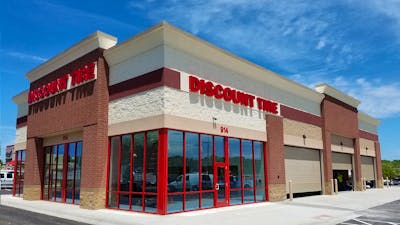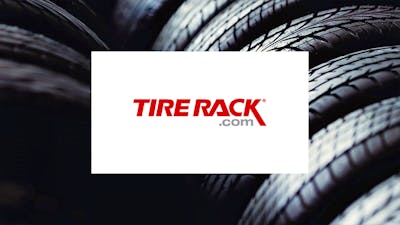Best Cheap All Terrain Tires
Buying new tires is an annoying process for many people, and it becomes even less entertaining when the prices are high. The good news is that there are affordable tires in every category, including sturdy all terrain tires. Your off-roader needs special tires to conquer rough trails and terrain, so it’s best to find a tire that is high quality in addition to being affordable. We’ve scoured the internet to find the best deals on tires and brands that consistently perform well for less money. Here are our picks for the best all terrain tires.
Get the Best Deals on Tires
Best Cheap All Terrain Tires 15 to 17 Inches:
- Yokohama Geolandar A/T GO15 : Finding a tire of any type that can compete with the Geolandar’s 60,000-mile warranty and its bargain-basement price tag will be difficult.
- Kumho Road Venture A/T 51 : Kumho is well known in the tire world for making affordable tires with desirable features, long lifespans, and solid customer reviews.
- Falken Wildpeak A/T3W : No surprise here. The Falken Wildpeak is an insanely well-reviewed tire that brings incredible off-road performance, great customer reviews, and a decent price.
Best Cheap All Terrain Tires 18 to 20-plus Inches:
- Firestone Destination A/T : The Destination A/T provides solid off-road capabilities with a level of on-road refinement not often found in tires at any price point.
- Nitto Terra Grappler G2 : The Terra Grappler G2 tires are made in the United States and offers great wet and snow traction.
- Falken Wildpeak A/T3W : The Falken Wildpeak A/T3W is a great tire that comes in several sizes. Its price tag lands a bit above the other tires on our list, but it’s still deep in affordable tire territory.
When we research cheap all-terrain tires, we have to take into account the tires’ lifespan, customer reviews, and availability in addition to the cost. We steer clear of tires that have few or no customer reviews and try to balance in things like longevity and warranty when making our decisions.
Original Equipment All Terrain Tires
All terrain vehicles are a completely different animal than standard passenger vehicles. They leave the factory with larger tires, and while you may like the tires your off-roader has now, there’s nothing stopping you from changing to a tire brand or type that fits your driving style more appropriately. Just because a Jeep has all-terrain tires from the factory does not mean you can’t switch to a tire model that provides better on-road performance if you spend more time driving on pavement.
Top Replacement Tire Brands for All Terrain Trucks and SUVs
We’re going to focus on off-road tire brands here, but keep in mind that you don’t have to buy off-road tires to replace your vehicle’s original equipment rubber. Take a step back and assess your driving habits before jumping in on new tires.
15- and 17-inch All Terrain Tires
- Cheap: Yokohama
- Crazy low pricing
- Solid all-around performance
- Easily found at most major tire retailers
- Road-going behavior could be better
- Not always the longest lasting
- Mid Cheap: Kumho
- Huge variety and selection
- Almost universally well-reviewed by customers
- Affordable price tag in almost all sizes
- Depending on the size, they can be not so cheap
- Could be better on pavement
- Better, Still Cheap: Falken
- Wonderful customer reviews
- Long treadlife and strong load ratings
- Can go head-to-head against tires costing much more
- Can be loud on pavement
18-, 19, and 20-inch A/T Tires
- Cheap: Firestone
- Suitable for a wide variety of vehicle types
- Great snow and wet performance
- Innovative construction techniques for long life
- Can be noisy on the road
- Not always the cheapest
- Mid Cheap: Nitto
- Made-in-America models
- Wide availability and sizing
- Affordable price tag in almost all sizes
- Not as refined on the road
- Not always the cheapest
- Better,Still Cheap: BFGoodrich
- Incredible wet and snow performance
- Wide variety of sizes available
- Both the All-Terrain and Mud-Terrain tires offer class-topping performance at mid-range pricing
- More expensive unless you find a deal
- Price
When Should You Replace All Terrain Tires?
Some people mistakenly look at beefy all-terrain tires and assume that they’ll last significantly longer than traditional tires. That may be true in some cases, but all-terrain tires usually live a rougher life and are put through much more demanding driving scenarios than standard passenger tires. For this reason, it’s important to understand that your driving style and where you drive will have a big impact on your tires’ longevity.
Some all-terrain tires carry warranties that stretch to well over 60,000 miles, but some are only rated at about 20,000 of usage. That’s about the average for the more capable A/T options on the tire rack. Weekend and occasional off-roaders can get tires with longer road wear ratings by sacrificing some of that off-pavement capability. And some people keep both on- and off-road tires for their rigs and swap out when hitting the trail and hitting the streets.
What most people are not aware of is that tires also have a usable shelf life. They can “go bad” after their “use by” date. That date, per Department of Transportation standards, is five years from the week of manufacture. To find out if your tires are out of date, look for the raised DOT numbers on the sidewall. These are required by law and consist of three sets of four numbers each. The first two sets indicate compounds and other information. The third set is the date of manufacture. The first two numbers are the week the tire was made and the second two are the year. A date code of 3217, for example, indicates the tire was manufactured in the 37th week of 2017 (between September 11 and 17th).
More information about your tires can be learned from other inclusions on the sidewall and sales information. Tires are printed with Uniform Tire Quality Grade (UTQG) ratings. These are a voluntary standard tire manufacturers have created to give quick indicators of how the tire is expected to be used. The UTQG usually appears after the tire’s name as a three-digit code. This code usually looks like “300 A B” or similar. The number is a durability rating, the first letter is the traction rating for wet pavement, and the third letter is the tire’s high-temperature resistance rating.
Using our example:
- 300 - The durability rating of the tire, with the control tire having a tread life of 100. Tires are run on a 640-kilometer course for a total of 11,520 kilometers. Tire tread depth is measured every 1,280 kilometers. The projected tread life for the overall course is then translated into this number. A 100 is a tire which is completely used up in the 11,520km. The higher the durability number, the longer the tread life. So a rating of 100 means the tire is good for 7,158 miles. A 300 rating means the tire is rated for about 21,000 miles.
- A - This is the Traction rating of a tire when stopping on pavement in wet conditions. It’s an indicator of the safety of the tire. The highest letter grade is AA, followed by A, B and C.
- A - The second letter rating in the UTQG is the high-temperature indicator. This is how well the tire should withstand extreme heat such as that of desert environments and higher speed driving (more on speed ratings later). A is the highest, followed by B and C.
Things to remember about all-terrain tires are that first, their date code is often more important than mileage totals. After a tire gets beyond five years of age, the compounds in it begin to change. Especially those which protect the tire from ultraviolet sunlight and other rubber-destroying things in the environment. This can be far more detrimental to A/T tires than can tread wear. Further, many all-terrain tires do not have a UTQG rating at all, as they often have low life expectations or aren’t subjected to wet pavement tests. Many manufacturers also do not include road hazard warranties with all-terrain tires as they are more likely to be punctured due to rough use than are street tires.
Why Not Replace with Original Equipment Tires?
The first thing we’ll say here is that there’s absolutely nothing wrong with replacing your tires with the same brand. The most important thing to keep in mind here is that you should be shopping for tires that fit your lifestyle and your driving style, and don’t have to follow in the footsteps that your vehicle’s manufacturer set out with its tire choices.
Using the OEM tires for your vehicle is an easier choice and it takes a lot of the legwork and decision making out of the process. For many people, that’s just an easier way to do things with the knowns being more predictable than the unknowns. Nothing wrong with that.
Most all-terrain vehicle owners purchase new tires about every three years, depending on driving habits. Those tires are your most important piece of safety and capability equipment and thus are an extremely important part of your rig. Where the rubber meets the terrain is the single most critical thing for both on-road driving (safety) and off-road driving (capability).
So for many buyers, shopping around to find the absolute best tire for their needs is very important and the OEM tread that came with their rig may not fit those needs’ criteria.
Changing Tire and Wheel Sizes
Most all-terrain vehicles like trucks and SUVs come with 15-, 16-, or 17-inch wheels. Some come with larger 19- or 20-inch wheels instead. Regardless of the OEM wheel size, one rule of thumb holds true no matter what is being done to the tires and wheels on a rig: total diameter must remain the same. The only exception to that rule is when major changes to the vehicle’s other components (including sensors, axles, etc) are being made. Any given vehicle, whether a street car or extreme off-road Jeep Wrangler, will have its engineering tuned to a specific diameter of wheel and tire.
What this means is that if the total diameter of your tire and wheel (tire mounted on wheel) is 40 inches, then changing either the tire or the wheel size must result in having the same diameter of 40 inches. Thus a larger wheel means a smaller tire to compensate and vice versa. This relationship between wheel diameter and tire height is very important. We’ll talk more about tire sizes in the next section.
So what are the reasons for downsizing or upsizing wheels or tires?
Downsizing wheels has advantages:
- Better ride quality – A larger tire sidewall means more cushion when the going gets rough.
- Cost reduction – Tires made to fit large wheels are generally more expensive than are tires meant for smaller wheel diameters. Especially in all-terrain and off-road tires.
- Seasonal changes – There are more winter tires available for smaller wheel sizes.
- Off-road – There are far more off-road tire options in the 18-inch and smaller wheel diameters than there are in larger diameters.
Going up in wheel size has benefits:
- Better handling – A thinner sidewall profile means better grip and handling because thinner walls are generally tighter.
- Better looks – While subjective, many people believe that larger wheels just look better, especially on larger vehicles.
- Better braking – A shorter and wider wheel has better stopping power than does a taller, more forgiving tire.
- On-road - Because many all-terrain vehicle owners don’t necessarily go off-road very often, a larger wheel and thinner sidewall may mean better on-road comfort and feel.
Reading Tire Sizes
Tires come in one shape and hundreds of sizes. The thing with all-terrain tires is that they can sometimes be sized differently than their more traditional counterparts. As we’ll discuss in a moment, some all-terrain tires are sized in inches. There’s also the issue of size itself, as most all-terrain tires are significantly larger than traditional tires.
Before the more universal, metric tire measurements became common, most tires were measured by sidewall height and/or overall diameter along with a wheel size opening measurement. We still see, especially in off-road, tires measured as “33 x 16.5” or similar. These are inch measurements of the tire’s height and width. This number would be followed by an R15 or just 15 indicating a wheel size--in this case 15 inches. This way of measuring is specific to the U.S., however, and is now usually in favor of a more universal, international option for measurement.
Most tires are measured with a width followed by a ratio and then a wheel size. So an LT285/70R17 tire (the LT meaning “light truck”) can be read as:
- 285 - is the width of the tire from one sidewall to the other in millimeters. This tire is 285mm wide.
- 70 - indicates the aspect ratio of the sidewall height. This is calculated as a percentage of the tire’s width. In this case, it’s 70 percent or of the tire’s width (70% of 285 is 199.5mm).
- R - means radial tires. Radials are the most common type of automotive tire and have fabric woven in at various angles with tread that is strengthened with additional layers of rubber.
- 17 - is the wheel diameter the tire fits on.
Some tires will have additional information after the wheel size, such as the “121/118R” on many all-terrain tires:
- 121 - is the tire’s load rating, for which a universal chart is used to convert this number into pounds or kilograms.
- R - is the tire’s speed rating, as indicated on another universal chart which converts the letter to miles or kilometers per hour.
- Other letters could also be included for tire inflation minimums/maximums, terrain usage, total load range (by weight per tire), etc.
Knowing the wheel diameter and tire size, it’s possible to calculate the total diameter of the tire. Using the information above, we now know that the total diameter of the 285/70R17 in question is 24.85 inches. We get that by converting the 199.5mm tire height to inches (7.85) and adding that to the 17-inch wheel diameter.
Knowing that total diameter, we can calculate what tire size we’d need if we were to go to a 15-inch wheel or a 19-inch wheel. That two inches of wheel would mean adding or subtracting two inches from the tire’s sidewall. It seems like a lot of math, but most tire shops have charts that do all of this for you. Numerous online resources also have tools for doing this without racking your brain for some long-forgotten middle school algebra.
In this look at tires, we’ve focused on all-terrain (A/T) tires almost exclusively. There are several types of tires, though, and it’s worth knowing the general attributes of each:
- Touring and all-season tires - provide a smooth ride, good wet and dry traction, decent winter traction, and longer tread life. These tires are acceptable for winter use but can’t be expected to provide the traction and stopping power that a dedicated winter tire can.
- Performance tires - are focused on providing confident handling, better wet and dry traction, and a sporty feel. Their higher grip and speed ratings come with a tradeoff of shortened tread life and reduced ride quality.
- Winter and snow tires - are made with special rubber compounds that maintain grip and pliability when temperatures drop. They are also built with special tread patterns to maximize the vehicle’s ability to start and stop on very slippery roads.
- All-terrain tires - are built to maximize off-road traction and provide good durability overall. Their construction means more noise and less comfort on the road, but winter traction and tread wear is acceptable.
Shop Tires Online and Save
Online tire prices are usually less than in store

All-Terrain Tire FAQ
- What is the most aggressive-looking all-terrain tire?
Looks are great, but they don’t have a big bearing on how a tire actually performs. We’re big fans of raised white-letter tires, but we wouldn’t choose that as the most important factor in buying a tire. Pick one with solid ratings, such as the BF Goodrich All-Terrain T/A K02 that looks as good as it performs.
- What is an all-terrain tire?
An all-terrain tire is built to provide decent wet and dry weather traction on the road, but can also be pressed into duty in off-road situations. They have stiffer sidewalls to resist punctures, and heavier lugs to discharge snow and mud. They can often have the three-peak/snowflake symbol that denotes a winter-rated tire. They’re a good compromise between a highway-performance tire and a mud terrain tire.
- What’s the best all-terrain tire for the money?
Right now, that looks like the Kumho Road Venture AT51, which gets excellent consumer ratings, and is generally available at a pretty reasonable price.
- Are all-terrain tires good on the highway?
Years ago, all-terrain tires used to growl on the highway and weren’t generally acceptable for long stretches of interstate. These days, though, a good all-terrain tire is a decent choice for the highway, and will get you to your destination when the road turns to dirt and mud.
- What is the best A/T tire pressure?
This will depend on whether you’re on or off the road. Inside the driver’s side door of your vehicle there is a white and yellow label with tire inflation indicators on it. Follow those numbers. Most on-road use will have tires inflated to 32 or higher PSI while off-road may be as low as 15 or 20 PSI for better grip. Note that the pressure on the tire itself is never the correct setting, but rather a maximum.
- How often should I rotate my all-terrain tires?
Tire rotations vary by manufacturer, but in general, the recommendations of your vehicle’s manufacturer are a rough starting point while the recommendations of your tire manufacturer are probably more precise. Typical rotation intervals are between 5,000 and 7,000 miles, though off-road use could mean less rotation is needed. It’s important to remember that off-road vehicles are usually rear-wheel drive by default (when not off-road) and four-wheel drive otherwise. So wear will be different according to how much of either you tend to do.
- What is the best A/T tire change kit?
Most vehicles come with their own tire change kit, but you may want to carry an extra roadside emergency kit with an upgraded lug wrench, jumper cables, and emergency markers just in case. It’s also a good idea to carry a larger vehicle jack and some gear for digging out of mud and sand when off-roading.













